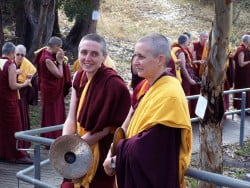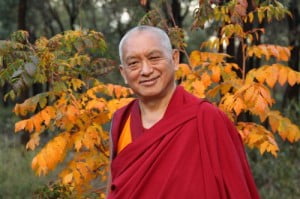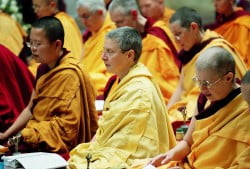Renunciation and the Ordained Life
By His Holiness the Dalai Lama
“May I never be reborn again in states where I descend to the lower realms. May I attain the perfect human form with spiritual freedom and opportunity. Right from birth, may I never be attached to the pleasures of mundane joys and inspired by thoughts of renunciation, may I strive without respite for the pure life.”
Although right from birth, it is out of the question to cultivate such thoughts and detachment, the prayer nonetheless is made that from early on, may I be able to free myself from attachments to the pleasures of mundane joys so that I’m not tied to mundane existence. Inspired by thoughts of true renunciation, may I strive to engage in the conduct of a pure life.
‘Pure life’ refers to the life of a monastic order, the life of an ordained monk. This is in keeping with the example of the master, Buddha himself. In Buddha’s own life, he grew up initially as a Prince in a kingdom, showered with all the luxuries of princely existence, but he gave up all of these and cultivated detachment and sought the life of an ordained practitioner. As the Tibetan expression goes: “the teacher’s example of the past must be followed by the disciples of the future.” However, this is not to suggest that in order to attain true liberation or nirvana, it is indispensable for everyone to become a celibate and join the ordained life. However there is an understanding that an ordained life is the best, most suitable circumstances or framework within which one can make spiritual progress and work towards the attainment of liberation from samsara.
“May there be no obstacles to renunciation from family, friends, and possessions. May I achieve without hardship, conditions favorable to an ordained life.”
Not only may I be able to develop from within a deeply felt admiration for the ordained life and seek that; may I also not encounter obstacles that hinder my fulfillment of this aspiration. In fact, the aspiration is made that my family, friends, possessions, and other external conditions be favorable towards the fulfillment of that aspiration.
The significance of the lines that say: “May I strive to seek the pure life inspired by thoughts of true renunciation,” This is to underline the importance of engaging in the life of a true renunciate. It is important to have that as the basis of your monastic life because it is possible historically, both in India and Tibet, that there were people who took the life of an ordained member, not out of the motivation of attaining true renunciation and attaining liberation from samsara, but rather as an escape from some fear of retribution or punishment. Sometimes it happened that people took refuge in the monastic life to protect themselves against certain threats or fears. It is possible that in some cases, people also join the monastic life as a way to earn a living, or simply as another kind of lifestyle. These two kinds of ordained life are not really the life of a renunciate. Therefore in Gunapraba’s text on monastic ethics, right at the beginning of the opening passages, it states: “Herein I shall present the monastic ethics of a renunciate.” He underlined the importance of renunciation as the basis for joining the ordained life.

Earlier, we spoke about the core practice of morality, the three higher trainings, the higher trainings of morality, concentration, and wisdom. When we speak about the higher training of morality in Buddhism, we generally speak about two categories. One is morality related to lay practitioners, such as upasakas (lay vows) and the vows of a monastic. Within the lay practitioner’s vows, one can take all five precepts, which includes celibacy or all five precepts, which includes avoidance of sexual misconduct, or one can take just three or two or one precept. One can also take lay vows on the basis of taking refuge in the Three Jewels. It is possible due to lack of the right conditions that sometimes individual practitioners’ sense of courage and commitment is so weak that they are only able to commit to a life of ethical discipline on a short term basis. For such practitioner there is the possibility of taking these vows and precepts on a daily basis, that is the gen yen, one-day vows.
For monastics, there are novice and fully ordained vows for both male and female. In Tibet, historically among the practitioners there were two communities, the community of white robes and long hair, and the monastic community of yellow and red robes. The community of white robes refers to lay practitioners, particularly Vajrayana practitioners where they don’t assume the external appearance of a monastic order. In some cases, you find that those who engaged in long-term retreat kept their hair, never cut it and kept it plaited and tied up. There is a textual basis for these kinds of conduct. In the tantric and Vajrayana texts, we find the reference that the members of the white robes community need not observe the external forms of monastic life, but so far as key precepts are concerned, must practice them all. So historically these lay practitioners take upasaka vows, and on that basis, they take bodhisattva and tantric vows and follow that line. On the other side, members of the monastic order-the foundation for their life is the monastic discipline and the life of an ordained member-cut their hair, adopt a particular set of robes and appearance, and lead a celibate way of life. So historically there evolved these two distinct lines of practitioners, and each pursue his life with a certain clarity and direction. However these days, it does seems that we sometimes find practitioners who neither seem to be in one camp nor the other, somehow they seem to fall in the middle. In fact one Tibetan master, Drugpa Kunlay, is said to have remarked that of those who are neither yellow nor white, a lot of seem to be in the hell realms suffering so much. There is a point to this: it is that whatever line of practice you pursue, whether as a monastic member or a lay member, it is important to follow that with clarity.
It is important to know that when you change your physical appearance, by either adopting a set of robes or a particular kind of costume or whatever it may be-especially in the case of monastic robes-it is very important that such a change in physical appearance, such a change of clothes, should only be adopted as a kind of expression of a particular change in direction that you have taken. That is to say you have taken a specific set of vows and precepts, and it is to demonstrate this fundamental change in your life that you put on that particular appearance. Otherwise there is a danger that people either without any basis of taking vows or out of whatever the motivation may be assume a particular appearance with robes. In this lies a danger of dilution. Also, whether or not there is an intention within the person, there is a danger of a certain kind of charlatanism; at least to the appearance or perception, people can become charlatans. There is that danger. Sometimes I meet people who at one time seem to be wearing white robes and at another they seem to be in yellow robes and yet other times, even in red robes! So even I get confused when I meet these people! In this context, I often make the following remarks:
(His Holiness made a few comments about how some monks would get attached to external apparel that is not part of one’s robes but which show certain status. He told the story about Atisha going to Tibet. When he arrived in the kingdom of Ngari, the lamas and monks, to welcome him, dressed up in impressive costumes and headdress, riding horses. Atisha was appalled. He covered his head with his robes and said ‘Tibetan ghosts are coming.’ He didn’t want to see lamas and monks who didn’t maintain the appearance of the monastic order. When the monks found that out, they got down from their horses, took off their impressive gear, and put on their simple monastic robes and came in a procession to receive Atisha. Atisha was then very pleased.)
Sometimes it seems like instead of paying greater respect to robes ‘given’ by the Buddha, we Tibetan monks are more attached to apparel that is given by high officials, etc. These are very sad signs of potential degeneration of the Dharma. Kunnu Lama Rinpoche said, “If the members of the monastic order do not retain their integrity grounded in humility and stability, and indulge in all sorts of things, those will be the early indications of the degeneration of the Dharma.”
“After entering the order, may I never be stained by transgressing the precepts, whether natural or specially prescribed, taken before the ordained masters.”
Here it refers to two kinds of precepts. One is a precept which relates to avoidance of activities, which are by nature negative, such as the acts of killing. Killing is a negative activity for anybody who engages in it whether the person committing it has taken specific vows or not, whether the person is a monastic member or not. One can say killing is by nature a negative act. However, there is another category of precepts that relates to specially prescribed actions; e.g. avoidance of eating after lunch is one of the precepts of the members of the monastic order. If you don’t have the vow, then eating after lunch is nothing negative. But if you are a member of the monastic order, then there is this specific precept that you do not eat after lunch. So this is what is meant by specially prescribed precepts. So the aspiration here is made that after entering the monastic order may I never be stained from transgressing any of these precepts.
In this verse, the text states that the whole purpose of joining the ordained life is to engage in the practice of Dharma. So the core activity-the task of an ordained member-is to engage in studies and engage in the practices. Such practices as single pointed meditation require grounding and some understanding; otherwise there is nothing to practice. So what we require is to first cultivate deep learning and understanding. Then that understanding needs to be implemented through single pointed practice. In other words, the task of an ordained member is to engage in all the activities such as teaching, studying, writing, composition, and so on, so that you uphold the precious Dharma.
Once you have established such a basis and realize that the primary task is to uphold the Dharma through these activities, then you realize that not only for your learning but also to prepare yourself for that you need to seek the guidance of a spiritual teacher. The basic qualities that are necessary on the part of the teacher are that the person should have a subdued, tamed mind, have great learning in the scriptures, and have compassion towards others, especially towards the disciples. Another important quality is to have a sense of commitment and a certain invulnerability towards feelings of discouragement and becoming demoralized. In other words, the teacher must possess all the essential qualities that are necessary for sustaining the students.
Colophon
Extracted from teachings on “THE PRAYER OF THE VIRTUOUS BEGINNING, MIDDLE AND END” Pasadena, California, 12 – 14 Oct 1999. Transcribed by Ven Tenzin Tsomo and edited by Thubten Jinpa.



